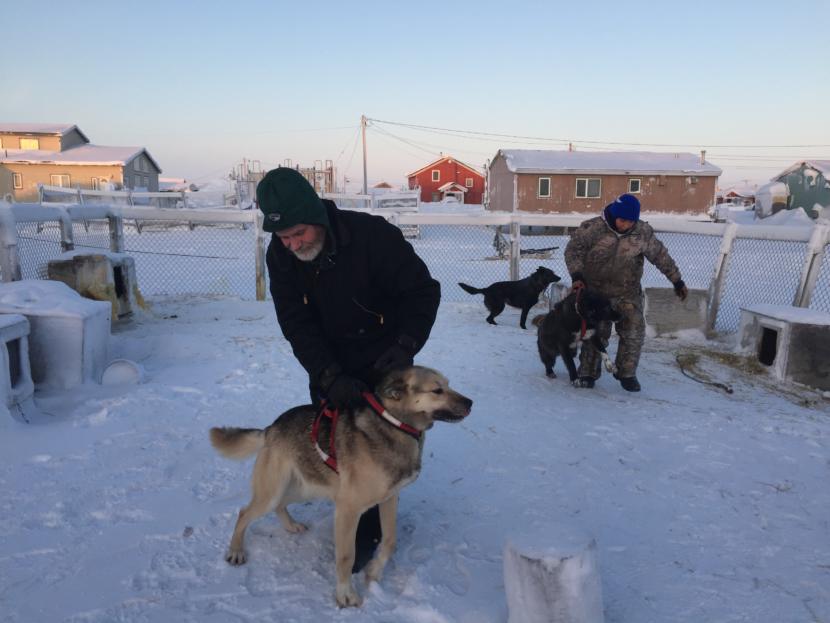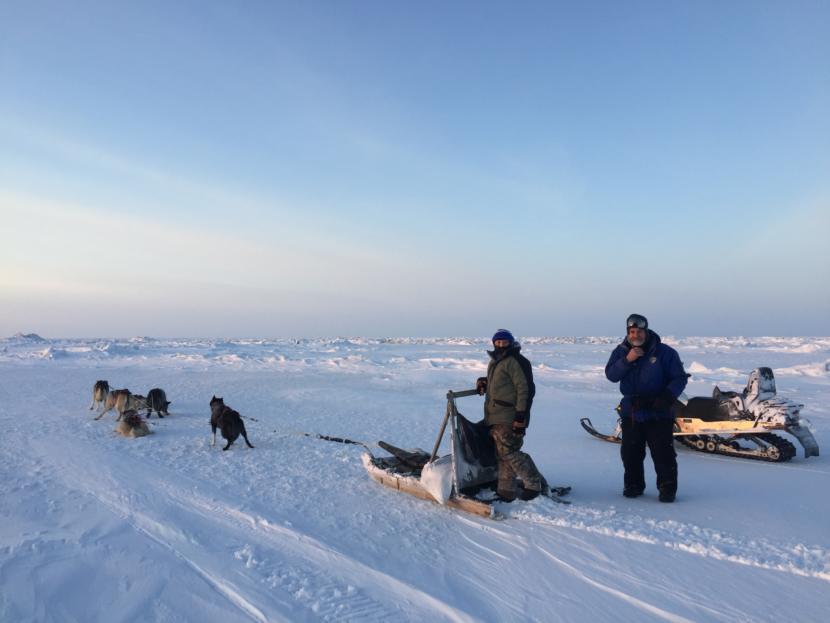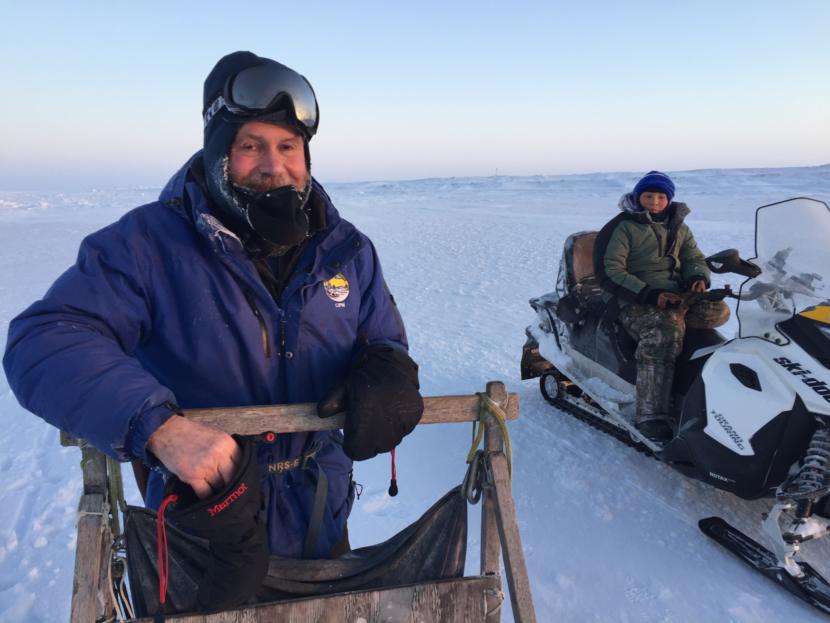
For hundreds of years, dog teams powered long-distance travel in northern Alaska.
Of course, now snowmachines, planes and cars have pretty much taken over the job of getting people around the North Slope.
But in Utqiaġvik, there’s still one dog team left, and their musher has been getting around the tundra by dogsled for more than 30 years.
It’s a beautiful afternoon with an orange sun blazing low in the blue sky, as Geoff Carroll and his 13-year-old helper Asa Elavgak wade into the dog yard to get the dogs hooked up to the sled. The dogs are yelping with excitement, and in its eagerness, one almost hauls Elavgak off his feet.
“So if you lift them up like this,” Carroll says, lifting one of the dogs by its harness so only its back feet are on the ground, “you get ‘em in two-wheel drive instead of four-wheel drive.”
This advice only gets Elavgak so far. By the time he gets the dog over to the sled, he’s winded.
“Asa needs to get a little bit bigger to handle these dogs,” Geoff jokes.
“Yup!” Elavgak agrees with a laugh.
After all the dogs are linked up to the line, Carroll stands on the back of the sled and shouts “KIITA!” (which means “let’s go” in Iñupiaq) and we’re off.
Suddenly, everything goes quiet — at least where the dogs are concerned. The only sounds are the squeaking of the snow, the creaking of the sled and the occasional thumps as we barrel over a mound or divot in the terrain.
We pass through the space between houses, across residential streets, and head out over the tundra and frozen lagoons north of town.
“Bouncing over the sastrugi,” Carroll narrates as we rattle over wind-sculpted grooves of snow, the afternoon sun throwing our shadow against the white.
“About as pretty as anything gets, as far as I’m concerned,” Carroll says, absorbing the scene. “The wide open country and sun shining on the horizon, and all those beautiful colors in the clouds.”

Alaska is, of course, famous for its sled dog racing, but that’s never been where Carroll’s interest lies. He’s an expedition guy.
In fact, his introduction to mushing was on an expedition to the North Pole in 1986: Known as the Steger International Polar Expedition, it was a 56-day, 1,000 mile trek over sea ice by dogsled.
The trip was a tough one, says Carroll, with rough ice conditions that made for slow-going, and temperatures down to 70 below zero. But it left him with enormous respect for sled dogs. As he puts it, he got hooked. And within a year, Carroll had his own dog team.
Since then it’s been a passion of his, though never his day job. He moved up to Utqiaġvik the same year he was introduced to mushing, though he’d been working up there seasonally for about a decade already on bowhead whale surveys. He then spent 27 years as a biologist for the Alaska Department of Fish and Game, a job he retired from a few years ago.
Over his time living in Alaska’s far north, he’s done dozens of multi-day trips and visited almost all of the North Slope villages.
“You can head out the back door and mush 200 miles to Umiat and Anaktuvuk (Pass) or whatever,” he says.”Not a single road or power line or anything between here and there.”
I ask Carroll if he’s ever gotten lost.
“Gotten lost? Oh I used to be lost all the time before they invented GPS,” he says.
When Carroll says “lost,” what he means is that he only had a vague sense of where he was; he never got lost in a dangerous way. Nowadays he uses GPS to navigate, but back in the mid-1980s, when he was new on the North Slope, he didn’t have that option.
“When I first moved here, I figured out pretty quick that the only way you could really get out and see the country and do things was to find an elder that would take you along,” he recounts.
He says the elders he went out with knew the country so well, they could leave their houses and make a beeline straight for a hunting camp fifty miles from town without a compass.
“You could never figure out how in the world they could do that in this country without a lot of landmarks and things,” he says.

As we bump across the snow, Carroll describes some of the more memorable things he’s seen from this sled over the decades: the surprising sharpness of the dogs’ shadows in the moonlight, for example, and what a bunch of caribou looks like when you suddenly find yourself in the middle of it.
“Oh it’s just total chaos,” says Carroll. “The dogs don’t know what to do, the caribou don’t know what to do, and you’re all kind of moving along there in unison. Pretty cool.”
Carroll is the first to admit that dog mushing is not a very practical way to get around. You have to feed the dogs, take care of them, hook them up to the sled, put them back in their pen. With a snowmachine, on the other hand, you gas it up and you go. When I ask him why he’s the only one left in Utqiaġvik with a dog team, he says he’s not as pragmatic as most people.
Not that pragmatic, sure, but for Carroll, running dogs is about a lot more than getting somewhere. He loves the quiet of traveling by sled, and he loves the animals.
“I get to go out and run with … my six best friends,” he says. “Go out and run across the country, you know. They love it. I love it.”
He also says that it’s taught him some valuable life lessons.
“You learn a lot of patience,” he says. “You know, just kinda keep plugging away, plugging away and you get there eventually … Pretty good strategy for life, too. You just keep at it and, you know, if you really believe in what you’re doing, you make some progress towards it someday.”
Carroll says he would love to see dog sledding continue in Utqiaġvik after he retires from it. He’s given mushing lessons to both kids and adults over the years, but says he’s always looking for new people (who think they might enjoy a bit of non-pragmatic tundra travel) to share it with.
